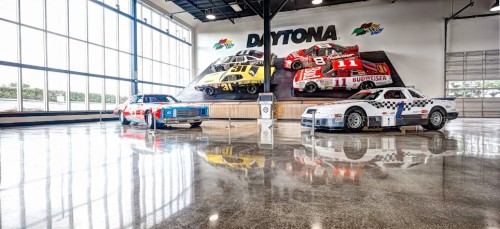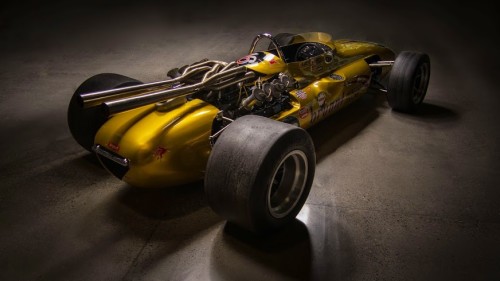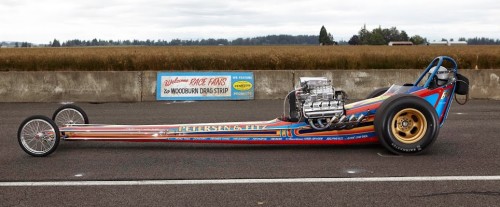
Petersen & Fitz Top Fuel Dragster, nicknamed -The Northwest Terror- after driver Herm Petersen. Courtesy World of Speed Museum
It’s not just airplanes that go fast…
There’s a new museum for horsepower hounds, speed fiends and fans of NASCAR, the Indianapolis 500 and anything with a motor that goes fast.
Located 15 miles south of Portland, Oregon, in Wilsonville, the World of Speed Museum is home to nearly 100 historic cars and motorcycles, along with race-themed simulators and a land speed record timeline.
A shrine to speed, the 80,000-square-foot museum is the first to document the history of motor sports in the Pacific Northwest. It also covers the story of motorsports that have roots in other parts of the country.
“You can see Nascar cars at the Nascar Hall of Fame in Charlotte, North Carolina. You can see Indy cars in Indianapolis, and you can see drag cars at Pomona (California),” said museum curator Ron Huegli. “We’ve got it all under one roof, including two notable hydroplanes on loan from the Hydroplane & Raceboat Museum near Seattle.”
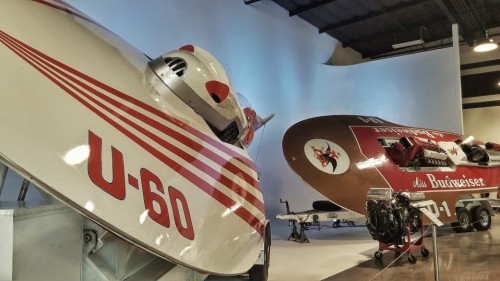
U-60 Miss Thriftway Hydroplane Boat and U-1 Miss Budweiser Hydroplane Boat. Courtesy World of Speed Museum
The museum’s Daytona display is a winner: a 15-foot-tall, 44-foot-wide structure built with the exact incline of the original 2.5-mile long tri-oval speedway in Florida.
The four restored vehicles mounted in the exhibit are from legendary Nascar drivers, and include Dale Earnhardt Jr.’s 2000 Chevy Impala, Jim Vandiver’s 1974 Dodge Charger, Terry Labonte’s 1988 Chevy Monte Carlo and Cale Yarborough’s 1979 Oldsmobile 442.
Other gems on display at the museum (some are on loan, while others are in the permanent collection) include Mickey Thompson’s famous record-breaking Assault and Indianapolis race cars. Both were built by Rolla Vollstedt in the basement shop at his home in Portland.
“We also have ‘Old Number One’ on display in our showcase salon area,” said Huegli. “It’s a 1929 Bentley built as a race car that took first place at the 24-hour Le Mans race in 1929 and 1930. It’s not something many people have seen beyond looking at it on the Internet.”
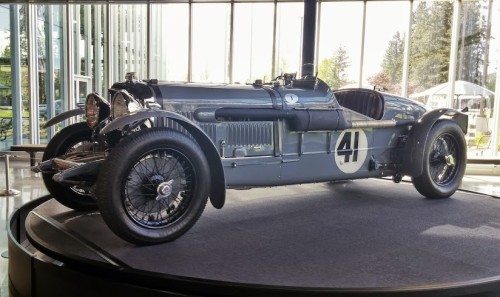
1929 Bentley-Old Number One- built as a race car. In 1929, the car took first place at Le Mans with Woolf Barnato and Sir Henry ‘Tim’ Birkin behind the wheel. World of Speed Museum
In addition to three real race cars set up as simulators (a 1962 Lotus Formula racing simulator, Adrian Fernandez’s 1995 Lola Indy Car and Johnny Benson’s 1998 Nascar Ford Taurus) the museum also has a gallery celebrating classic songs about fast cars including Ike Turner’s “Rocket 88,” The Beach Boys’ “Little Old Lady from Pasadena” and Commander Cody’s classic “Hot Rod Lincoln.”
Gearhead factor aside, there are some broader themes the World of Speed Museum is hoping to drive home.
“Motorsports represent American ingenuity,” said Huegli. “You’re presented with a problem and you solve it in a quest to go faster, which is the whole idea behind racing.”
There’s also the business side of motorsports. Nascar’s top earners pull down more than $170 million in aggregate earnings, endorsements and other income streams, and Nascar itself commands billions from television rights, in spite of faltering viewership.
“It’s huge,” said Huegli. “It’s hard to add it all up, but there are ticket sales at events, the billions of dollars generated by manufacturing related to motorsports, the budgets of all the race teams and the billions of dollars companies spend on sponsorships and advertising related to motorsports racing.”
Add in Formula 1 racing, which had revenue last year of close to $2 billion alone and, said Huegli, “the zeroes just keep adding up.”
(A slightly different version of my story about the World of Speed Museum first appeared on CNBC.)
